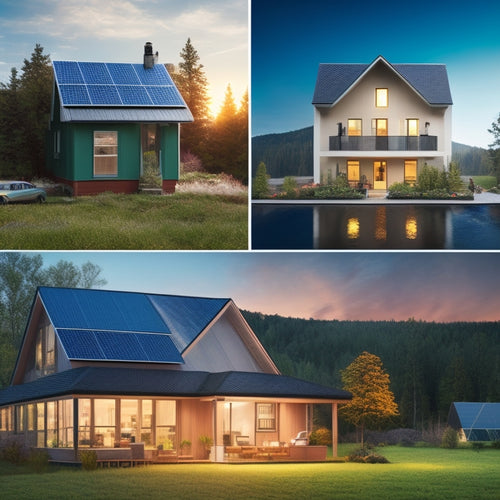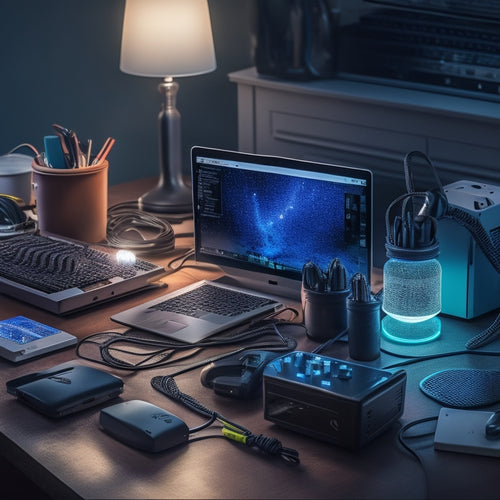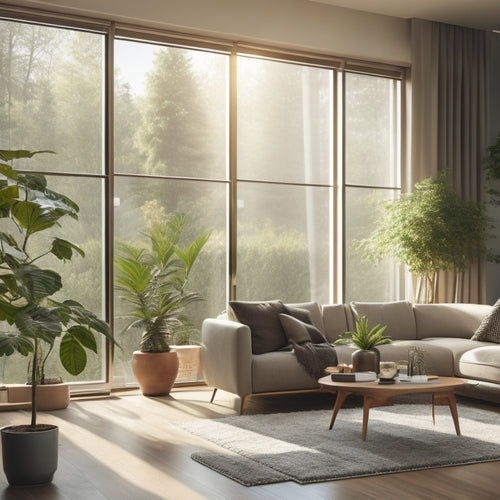
Why Grow Up? Vertical Gardens Transform Urban Living
Share
As you change your urban living space, you're not just growing up - you're bringing nature back into the heart of the city. Vertical gardens revitalize urban areas by enhancing biodiversity, mitigating the urban heat island effect, and improving air quality. By incorporating renewable energy solutions and community engagement, you're not only reconnecting with nature but also reducing your carbon footprint. From wall-mounted plant systems to hydroponic designs, every aspect of vertical gardening is customized to optimize space, increase crop yields, and purify the air. Now, take your urban oasis to the next level by exploring the endless possibilities of green infrastructure and sustainable urban planning.
Key Takeaways
- Vertical gardens revitalize urban spaces, enhancing biodiversity and mitigating the urban heat island effect through increased greenery.
- They improve air quality by integrating plants into cityscapes, fostering a healthier environment for urban dwellers.
- By incorporating renewable energy solutions, vertical gardens reduce carbon footprint, promoting sustainable urban ecosystems.
- Community engagement in design and maintenance fosters local participation, encouraging a sense of ownership and responsibility among residents.
- Vertical gardens enable urban dwellers to grow their own food efficiently, contributing to cleaner air, reduced pollution, and increased food security.
Urban Space Revitalization Through Greens
As you navigate the lively streets of urban metropolises, it's hard not to notice the concrete jungle's suffocating grip on natural scenery. Vertical gardens offer a refreshing change, revitalizing urban spaces and reconnecting you with nature.
By integrating greenery into cityscapes, you can enhance biodiversity, mitigate the urban heat island effect, and even improve air quality. Community engagement is key, as local residents can participate in designing and maintaining these green oases.
Additionally, incorporating renewable energy solutions, such as solar panels, can power vertical gardens, reducing reliance on fossil fuels and carbon footprint. By doing so, you'll cultivate a sense of ownership and responsibility, promoting a more harmonious relationship between humans and the environment.
As you investigate the possibilities of urban space revitalization, you'll uncover that vertical gardens are more than just a pretty face – they're a powerful tool for reshaping the urban environment.
Vertical Garden Wall Installation Eco-Homes
When you're designing an eco-home, you're likely looking for ways to maximize space while minimizing environmental impact. That's where vertical garden wall installation comes in, offering wall-mounted plant systems that don't take up precious floor space.
By integrating green roofs and rainwater harvesting systems sustainable station designs, you can create a thriving indoor ecosystem that purifies the air and beautifies your living space.
Wall-Mounted Plant Systems
Beyond the confines of traditional gardening, wall-mounted plant systems are revolutionizing the way you bring greenery into your urban living spaces.
You can now utilize the benefits of indoor gardening without sacrificing precious floor space. These systems provide a chic and modern way to showcase your plant aesthetics, adding a touch of natural beauty to your home or office.
With a wide range of designs and materials available, you can choose a system that complements your unique style. By incorporating renewable energy options, such as solar panels, into your wall-mounted plant system, you can further reduce your carbon footprint and create a sustainable oasis.
From lush green walls to graceful trellis systems, the possibilities are endless.
Space-Saving Design Options
You're likely wondering how to maximize the impact of your wall-mounted plant system while minimizing its footprint.
Fortunately, vertical garden design offers several space-saving options to optimize your eco-home's compact surroundings. When evaluating energy efficiency in your home, consider selecting and optimizing solar panels to reduce your reliance on fossil fuels.
Container gardening is a great approach, as it allows you to select planters that fit snugly against your wall, making the most of available space. Consider using slim, rectangular planters or trellises with built-in planters to add depth without taking up too much room.
Another option is to incorporate modular systems, which can be easily rearranged or expanded as needed. By choosing the right design elements, you can create a thriving, wall-mounted oasis that brings freedom and serenity to your urban living space.
Greenery Integration Methods
To seamlessly integrate greenery into your eco-home, consider the various installation methods for your vertical garden wall. You can choose from trellis systems, pocket planters, or modular structures, each offering a unique way to incorporate greenery benefits into your urban space.
When selecting an installation method, think about the urban aesthetics you want to achieve. Do you want a lush, verdant wall or a more minimalist, modern look? Consider factors like maintenance, drainage, and sunlight exposure to guarantee your greenery thrives.
It's also vital to assess your energy demands and load profiling energy audits to maximize the efficiency of your eco-home. By conducting energy audits, you can identify peak energy consumption and optimize your energy usage.
Maximizing Yield in Small Spaces
As urban dwellers increasingly turn to vertical gardens to grow their own food, maximizing yield in small spaces becomes a critical concern.
You'll want to optimize your container gardening setup to get the most out of your space. One approach is to use hydroponic systems, which can increase crop yields by up to 30% compared to traditional soil-based methods.
By providing plants with exact amounts of nutrients, you can promote healthy growth and maximize output. Consider using a vertically stacked hydroponic system, which can triple your growing space.
Additionally, choose compact, high-yielding plant varieties and employ pruning techniques to encourage bushy growth.
Air Purification Through Urban Farming
As you integrate urban farming into your vertical garden, you're not only growing fresh produce, but also creating clean air and reducing urban pollution.
By cultivating green spaces, you're effectively removing pollutants like particulate matter, ozone, and nitrogen dioxide from the air.
This dual benefit of urban farming can help you breathe easier and revitalize urban environments.
Clean Air Creation
You breathe in deeply, and the freshness of the air hits you, a welcome respite from the usual urban grime.
As you stand amidst the lush vertical garden, you realize that this isn't just a visual treat, but a refreshing change - literally.
Plants have an extraordinary ability to purify the air, removing pollutants and toxins, and releasing oxygen in return.
By incorporating urban farming into your daily life, you can greatly improve air quality.
The plant benefits are twofold - not only do they absorb carbon dioxide, but they also release negative ions, which can help reduce stress and anxiety.
Urban Pollution Reduction
Beyond air purification, urban farming tackles pollution at its root by reducing the urban emissions that contribute to poor air quality in the first place.
You'll be reducing your carbon footprint and relying less on industrial agriculture, which is a significant contributor to greenhouse gas emissions. By cultivating your own food locally, you're eliminating the need for transportation, packaging, and refrigeration – all major pollution culprits.
Urban farming also enhances biodiversity, as you're creating habitats for beneficial insects, birds, and other wildlife. This pollution mitigation strategy not only improves air quality but also supports ecological health.
Green Space Revival
Through innovative urban design, urban farming is reclaiming underutilized spaces, converting them into thriving green oases that combat air pollution.
You're probably familiar with community gardens, where locals cultivate plots of land, nurturing a sense of community and fresh produce.
Now, imagine these gardens heightened – literally. Rooftop farms are sprouting up, utilizing urban rooftops to grow everything from leafy greens to herbs.
These vertical gardens don't just provide a peaceful escape; they're also powerful air purifiers. By absorbing CO2 and releasing O2, they help combat the urban pollution you face daily.
As you navigate your city, you'll start to notice these green spaces popping up, revitalizing urban environments and improving the air you breathe.
Green Infrastructure for Healthy Cities
City planners are turning to green infrastructure as a key strategy for creating healthier urban environments. You're likely familiar with the concept of green roofs, but did you know they're just one aspect of a broader approach to urban planning?
By incorporating green spaces into city design, planners can increase urban biodiversity, mitigate the urban heat island effect, and even reduce air pollution. As you investigate your city, you may start to notice green walls, parks, and gardens popping up in unexpected places.
These elements work together to create a more sustainable, resilient urban ecosystem – and a healthier, happier you. By embracing green infrastructure, cities can provide a better quality of life for their citizens, and a brighter future for generations to come.
Sustainable Urban Planning Strategies
As urban populations continue to swell, forward-thinking planners are devising innovative sustainable urban planning strategies to guarantee these hubs remain livable and environmentally conscious.
You'll find that these strategies prioritize green spaces, renewable energy, and eco-friendly infrastructure. By incorporating sustainable practices, cities can reduce their carbon footprint and create healthier environments for residents.
Community engagement is also vital, as it assures that urban planning decisions align with the needs and values of local communities. By involving citizens in the planning process, cities can cultivate a sense of ownership and responsibility, leading to more effective and sustainable urban development.
Future of Urban Agriculture Trends
Your urban oasis is about to get a whole lot greener. As the future of urban agriculture trends unfolds, you'll see community engagement take center stage.
Residents will come together to design and maintain vertical gardens, nurturing a sense of neighborhood satisfaction and cooperation.
Technological innovations will also play a key role, with advancements in hydroponics, aeroponics, and sensor technology making it easier to grow fresh produce in even the most unlikely spaces.
With these developments, you'll have more control over your food supply and the freedom to create a sustainable, self-sufficient lifestyle.
As cities become greener, the opportunities for community building and innovation will flourish, laying the groundwork for a healthier, more sustainable urban future.
Frequently Asked Questions
How Often Do Vertical Gardens Need to Be Watered and Maintained?
In Singapore's Green Orchard project, you'll water your vertical garden every 2-3 days, depending on climate and plant type. For low-maintenance bliss, you'll also need to prune, fertilize, and monitor pH levels regularly, ensuring a thriving urban oasis that brings you freedom and joy.
Can I Grow Edible Plants in a Vertical Garden in My Apartment?
You can definitely grow edible plants in your apartment's vertical garden, optimizing space with tiered planters and selecting herbs like basil, mint, or cilantro that thrive in indoor conditions, providing fresh flavors right at your fingertips!
Are Vertical Gardens Suitable for Areas With Low Natural Light?
You can still thrive with vertical gardens in low-light areas by selecting plants adapted to shade or low light conditions, like Chinese Evergreen or Pothos, and optimizing your garden's design to maximize available light.
Can I Install a Vertical Garden on a Balcony or Patio?
You can definitely install a vertical garden on your balcony or patio, considering balcony design and plant selection; choose compact, low-maintenance plants, and make certain your structure is sturdy and securely attached to the balcony or patio railings.
Do Vertical Gardens Require Special Licenses or Permits?
As you envision your lush vertical oasis, don't get tangled in red tape: you'll need to steer through regulatory requirements and zoning laws, but with some research, you'll uncover the necessary permits and licenses to bring your green dream to life.
Related Posts
-

What Does Your Home Energy Audit Report Reveal?
Your home energy audit report reveals a detailed analysis of your energy consumption patterns, highlighting areas of ...
-

What Do Power Strips Do for Standby Energy?
You're likely aware that your devices, such as TVs and computers, continue to draw power even when turned off, a phen...
-

3 Eco-Friendly Automated Blinds for Contemporary Living
You're looking to raise your living space with automated blinds that not only exude contemporary style but also align...


